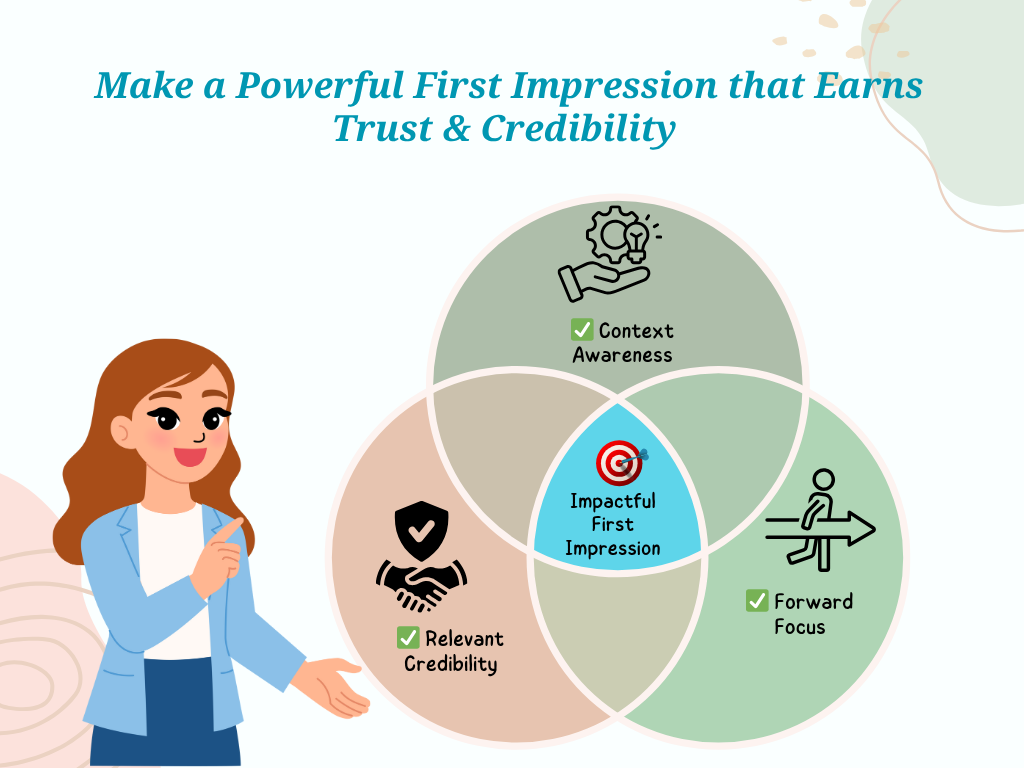Introducing Yourself Like a Leader: The PM’s Guide to Making an Impact
“Your introduction isn’t a biography; it’s your first act of leadership.” This guide gives you the 60-90 second framework that earns trust, answers unspoken questions, and sets projects up for success.
Iyanna Trimmingham
10/13/20257 min read


The conference room falls quiet. Fifteen stakeholders turn to look at you. This is your first meeting as the new project manager for a $2M digital transformation initiative that's already three weeks behind schedule.
What you say in the next 60 seconds will determine whether they see you as the solution, or just another PM who won’t last.
No pressure, right?
Here’s what many project managers get wrong about introductions: they think it’s about reciting their résumé. Years of experience. Previous companies. Certifications. But nobody in that room cares about your PMP credential right now. They care about one thing: Can you solve our problem?
Your introduction isn’t a biography. It’s a positioning statement. It’s your first act of leadership. And when done right, it builds immediate trust and credibility that sets the tone for everything that follows.
Why Your Introduction Actually Matters
People form judgments within seconds; research shows first impressions take shape in 7-10 seconds and are remarkably hard to change.
In project management, this matters even more because you often lead without formal authority. Your team doesn’t report to you. Stakeholders have competing priorities. You’re not their boss; you’re the person asking them to align around shared goals.
Your introduction is the moment you earn the right to lead.
Think about it from their perspective:
Is this PM going to make my life easier or harder?
Does this person understand what’s actually at stake?
Can I trust them to deliver without constant oversight?
Your introduction answers these questions before anyone asks them aloud.
What Makes a Strong PM Introduction Different
Most introductions follow a forgettable template: name, title, years of experience, vague statement about “looking forward to working together.”
That’s not an introduction. That’s an email signature.
A strong PM introduction includes three elements:
Context Awareness: You show you understand the situation, challenges, and what matters to the people in the room.
Relevant Credibility: You share specific experience that connects directly to the current challenge.
Forward Focus: You quickly shift from talking about yourself to talking about how you’ll help the team move forward.
Keep it to 60-90 seconds. Anything longer and you’ve lost them.
Preparing Your Introduction: Do This First
Understand Your Audience: Who’s in the room? Developers care about blockers; executives care about ROI. Tailor your language accordingly.
Know the Context: Is this a new initiative or a rescue mission? Don’t fake enthusiasm if the project is struggling. Authenticity earns trust.
Identify the Real Question
Each setting has an unspoken question:
New project kickoff: Why should we trust you to lead this?
Troubled project: How will you fix what’s broken?
Stakeholder presentation: Do you get what we actually need?
Team introduction: Will you make our work easier or harder?
Your introduction should answer that question directly.
Crafting Your Introduction: A Practical Framework
Open with Context (15 seconds)
Show awareness of the situation.
Weak: “Hi, I’m Sarah, your new project manager.”
Strong: “I know this project’s faced scope and timeline challenges. I’m Sarah, and I’m here to help us get back on track.”
Establish Relevant Credibility (20 seconds)
Give one concrete example that proves you can handle this challenge.
Weak: “I have ten years of experience across multiple industries.”
Strong: “I’ve led three ERP migrations like this one, and I’ve learned the biggest risks aren’t technical, they’re about alignment and communication.”
Focus Forward (25 seconds)
Set expectations for how you’ll work.
Weak: “I’m looking forward to working with all of you.”
Strong: “Here’s how I work: transparent communication, short feedback loops, and quick removal of blockers. My job is to make yours easier. If something’s in your way, I want to know immediately.”
Adapting Your Introduction to Different Scenarios
Executive Stakeholder Meeting
Unspoken question: Will this PM deliver results or waste our time?
Be concise and outcome driven.
Example: “I’m Iyanna, leading the customer portal redesign. I’ve managed four similar digital transformations that reduced support tickets by 15% post-launch. My focus here is hitting key milestones while managing integration risk. I’ll flag anything needing your input early.”
Why it works: Direct, measurable, business oriented.
Team Kickoff Meeting
Unspoken question: Is this PM going to micromanage us?
Be collaborative and empowering.
Example: “I’m Iyanna, and I’m excited to work with this team on the mobile app launch. You’re the experts, I’m here to align, remove obstacles, and ensure we have what we need to succeed. If you need something, come to me. If I’m in your way, tell me.”
Why it works: Respects expertise; establishes partnership.
Virtual Team Introduction
Challenge: Building connection without physical presence.
Show warmth and structure.
Example: “Good morning! I’m Iyanna, your PM for the supply chain optimization project. We’re across three time zones, so I’ll rotate meeting times and share weekly written updates to keep everyone aligned. My virtual door’s always open, message me anytime.”
Why it works: Acknowledges distance and offers solutions.
Written Introduction (Email or Slack)
Challenge: No tone or body language.
Be short, clear, and actionable.
Example: Subject: Introduction: Your PM for Project Phoenix
Hi team,
I’m Iyanna, managing Project Phoenix starting today.I’ve led similar process-improvement projects focused on cutting handoff delays and improving cross-team collaboration.
Here’s what you can expect:
Weekly updates every Friday
Quick daily check-ins for blockers
Transparent communication on timelines and risks
I’ll reach out individually this week to learn how I can best support you.
Looking forward to working together,
IyannaWhy it works: Scannable, sets expectations, shows immediate value.
For New or Junior PMs
If you’re just stepping into your first PM role, lead with partnership, not authority.
Example: “I know many of you have deep experience with this system. My focus is on helping us stay aligned and removing blockers fast. You’re the experts; I’m here to coordinate and support.”
Why it works: Shows confidence without overreaching authority.
Common Mistakes That Undermine Your Introduction
Talking Too Long
Your introduction isn’t a TED Talk.
✅ Fix: Time it under 90 seconds; trim anything non-essential.Being Too Humble or Too Confident
False humility sounds unsure; arrogance alienates.
✅ Fix: State facts, not boasts.Ignoring the Elephant in the Room
Avoid pretending everything’s fine when it isn’t.
✅ Fix: Acknowledge reality, it builds trust.Using Jargon or Corporate Speak
“Synergize cross-functional stakeholder alignment” = instant eye-glaze.
✅ Fix: Talk like a human.
Real-World Examples
Case Study 1: Rescuing a Failing ERP Implementation
The Situation:
Priya was brought in to take over a stalled ERP migration. The previous PM had been let go after missing three major milestones. The team was demoralized, executives were losing confidence, and vendors were threatening to pull out.
Her Introduction (Executive Meeting):
"I know this project hasn't gone as planned, and I understand the frustration. I've been brought in specifically because I've turned around two similar ERP projects that were behind schedule. The first thing I'm doing is a full diagnostic- I need 72 hours to understand exactly where we are and what's blocking progress. By Friday, I'll have a revised timeline and a clear plan to get us back on track. I won't sugarcoat the challenges, but I will be transparent about what's fixable and what's not."
What Made It Work:
Acknowledged the problem directly
Established relevant credibility (two similar turnarounds)
Set clear expectations (72-hour diagnostic, Friday update)
Balanced honesty with confidence
The Outcome:
Executives gave her the space to assess. Her Friday update was data-driven and realistic, which rebuilt trust. The project was back on schedule within eight weeks.
Case Study 2: Leading a Remote Team for the First Time
The Situation:
James was assigned to lead a software development project with team members in Seattle, Austin, and Japan. The team had been working together for six months under a previous PM who left suddenly. They were skeptical about another leadership change and worried about time zone challenges.
His Introduction (Video Call):
"Hi everyone, I'm James. I know change is hard, especially when you've already built momentum together. I'm not here to reinvent the wheel, I'm here to support what's already working and fix what's not. I live in Seattle, but I know that means some of you are starting your day when I'm ending mine. So, here's what I'm committing to: I'll rotate meeting times so nobody's always joining at midnight. I'll send written updates after every key decision. And I'll have dedicated overlap hours with each time zone every week. I want to hear from you; what's working? What's frustrating? Let's talk honestly."
What Made It Work:
Validated their concerns (change fatigue, time zones)
Made concrete commitments (rotating meeting times)
Invited feedback immediately
Showed respect for their existing work
The Outcome:
The team responded positively in the chat during the call. Within two weeks, they were communicating more openly, and blockers were surfacing earlier. James's willingness to adapt his schedule built significant trust.
Case Study 3: Introducing Yourself to a Skeptical Stakeholder
The Situation:
Linda was managing a marketing technology implementation. The CMO, her key stakeholder, had vocally opposed the project, believing it was a waste of budget. Her first one-on-one with him was tense.
Her Introduction:
"I know you have reservations about this project, and I respect that. Before we dive into timelines or deliverables, I'd like to understand your concerns. What would success look like for you? What would make you feel confident this investment is worth it?"
What Made It Work:
Didn't pretend the tension didn't exist
Led with curiosity, not defensiveness
Gave the stakeholder space to voice objections
Positioned herself as a problem-solver, not an adversary
The Outcome:
The CMO appreciated being heard. His concerns were valid, he worried the new system would slow down his team during peak campaign season. Linda adjusted the implementation timeline to avoid that window. The CMO became one of her biggest advocates.
Your Introduction Checklist
Preparation
☑ I know my audience and their concerns
☑ I understand current challenges and context
☑ I’ve identified the unspoken question they want answered
Content
☑ My intro is under 90 seconds
☑ I demonstrate context awareness
☑ I share one relevant experience
☑ I focus on collaboration and outcomes
☑ I avoid jargon
Delivery
☑ I’ve practiced out loud
☑ My tone matches the setting
☑ I can adjust to the room’s energy
☑ I have a clear transition to the next topic
Final Thoughts: Make It About Them, Not You
The paradox of a great introduction is this: the less you focus on yourself, the more impact you make.
Your audience doesn’t care about your credentials; they care whether you’ll make their work easier, reduce risk, and help them succeed.
When you shift from “here’s who I am” to “here’s how I’ll help,” everything changes.
Before your next introduction, ask yourself: What does this audience need to hear to feel confident in my leadership?
Answer that question, and you’ll never struggle with introductions again.

